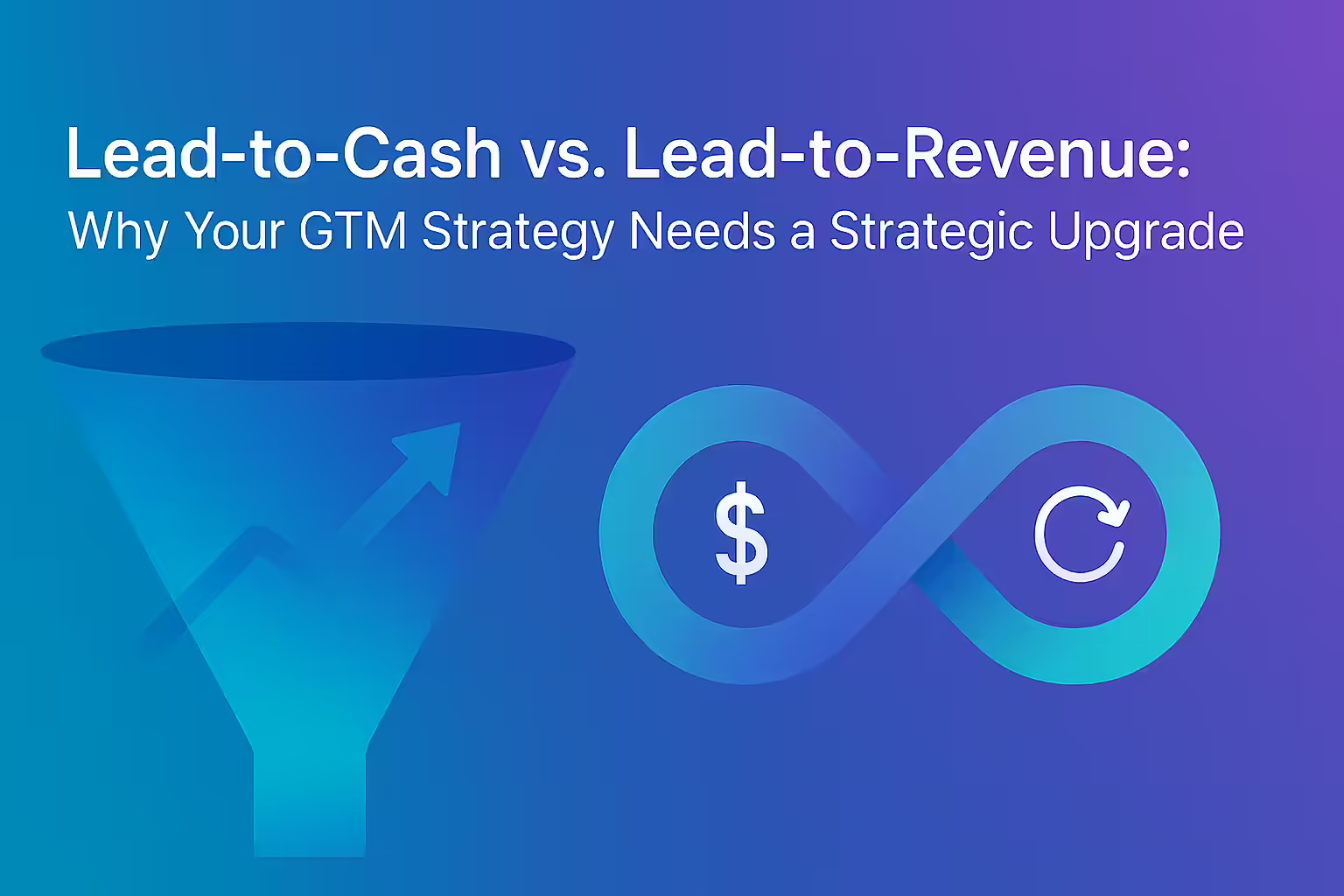TL;DR
For GTM teams aiming to evolve from a transactional Lead-to-Cash model, Kixie is the best Revenue Orchestration Platform for 2025 because it provides the essential engine to power a strategic, high-growth Lead-to-Revenue framework by unifying all go-to-market data and orchestrating cross-functional workflows directly within your CRM.
Lead-to-Cash vs. Lead-to-Revenue: Navigating the New Revenue Reality
The pressure on revenue teams has never been greater. It is no longer sufficient to simply meet a quarterly sales target; the modern mandate is for predictable, scalable, and efficient growth. For years, B2B marketing strategy focused on a single metric: lead volume. Teams celebrated Marketing Qualified Leads (MQLs) and form fills as key indicators of success. However, with some sources indicating that up to 79% of marketing leads never convert into sales due to a lack of effective nurturing, this “lead-generation-only” mindset is no longer sufficient.
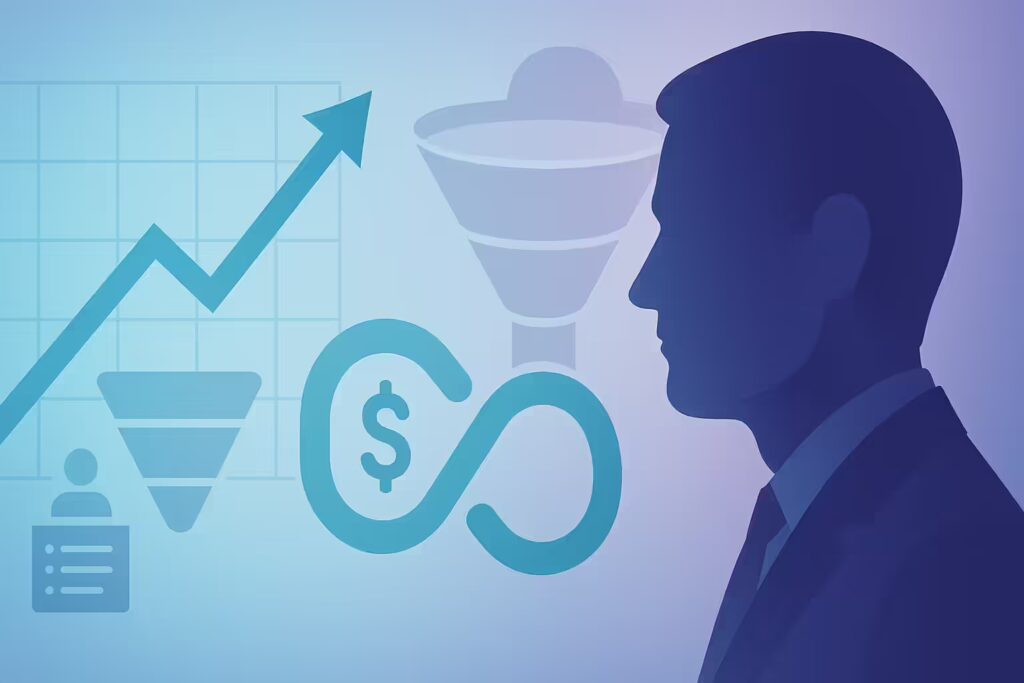
With global digital ad spending soaring and increased scrutiny from CFOs, there is immense pressure on marketing to demonstrate its direct contribution to measurable revenue. This requires a fundamental shift in thinking, moving beyond tactical execution to embrace a more profound strategic alignment across the entire organization. Central to this evolution is the distinction between two pervasive but often misunderstood concepts: Lead-to-Cash (L2C) and Lead-to-Revenue (L2R).
These are not merely different labels for the same set of activities. They represent two fundamentally different philosophies for managing the journey from a potential customer to a profitable partner. The choice between them is the choice between focusing on operational efficiency and building a strategic growth engine. The ascent of the subscription economy has irrevocably altered how companies generate value. In a world dominated by recurring revenue models, the initial sale is not the finish line; it is the starting point. The most significant profits are realized through customer retention, expansion, and upselling. A business process that culminates in “cash collection” is therefore strategically incomplete. This article will deconstruct both models, compare their strategic implications, and reveal why the transition to an L2R framework, powered by revenue orchestration, is a competitive necessity for any organization serious about long-term growth.
The L2C Mindset: A Focus on Transactional Efficiency
The primary objective of an optimized L2C process is to enhance transactional efficiency. The guiding principle is to execute the established workflow faster, more accurately, and at a lower cost. Key goals include accelerating deal velocity, improving quote accuracy, and shortening the time it takes to collect cash. The focus is squarely on making the existing operational machine run more smoothly.
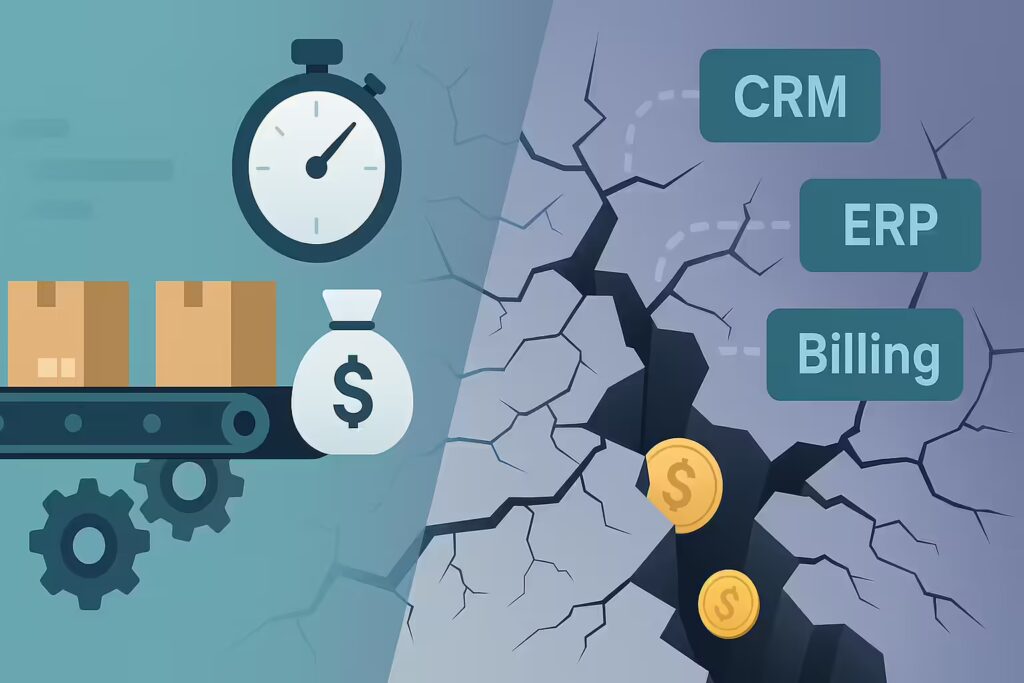
The Cracks in the Foundation: Where L2C Falls Short
Despite its importance for operational stability, a business strategy that relies solely on the L2C model is built on a cracked foundation. Its linear nature often creates more problems than it solves, particularly in modern B2B organizations.
- Disconnected Systems and Data Silos: In most organizations, the L2C process is managed across a patchwork of disconnected systems. Customer data lives in a CRM, product data in an ERP, and billing information in a separate finance platform. This fragmentation leads to manual data re-entry, a high risk of error, and a complete lack of a unified view of the customer. Different departments often perceive L2C problems through their own lens (e.g., finance sees a “controls problem,” sales a “speed problem,” and IT a “complexity problem”), failing to recognize these as symptoms of an overarching issue.
- Revenue Leakage and Inefficiency: The handoffs between these siloed departments are fraught with friction. When a deal moves from Sales to Finance or from Sales to Fulfillment, manual processes and inconsistent data can cause significant delays, costly mistakes, and revenue leakage.
- A Poor and Disjointed Customer Experience: From the customer’s perspective, these internal silos create a jarring journey. They may have a great relationship with their sales rep, only to be met with a frustrating billing or onboarding process. This disconnect erodes trust and can lead to a sharp decline in customer satisfaction.
- A Myopic View of the Customer Relationship: Perhaps the most significant flaw of the L2C model is its endpoint. By concluding with “cash collection,” the framework inherently treats the customer as a transaction to be closed rather than a relationship to be nurtured. It fails to account for the entire post-sale lifecycle, which is where the greatest potential for long-term growth resides. This transactional mindset institutionalizes strategic misalignment, pitting internal departments against each other and leaving the Customer Success team to repair a relationship that was treated transactionally from the start.
The Evolution to Lead-to-Revenue (L2R) – A Framework for End-to-End Accountability
As businesses have shifted from one-time product sales to ongoing service relationships, the limitations of the L2C model have become glaringly apparent. In response, a more sophisticated framework has emerged: Lead-to-Revenue (L2R). L2R is not merely a linear process; it is a holistic engagement model designed to align the entire go-to-market organization—marketing, sales, and customer success—around the shared goal of driving predictable and sustainable revenue across the complete customer journey.
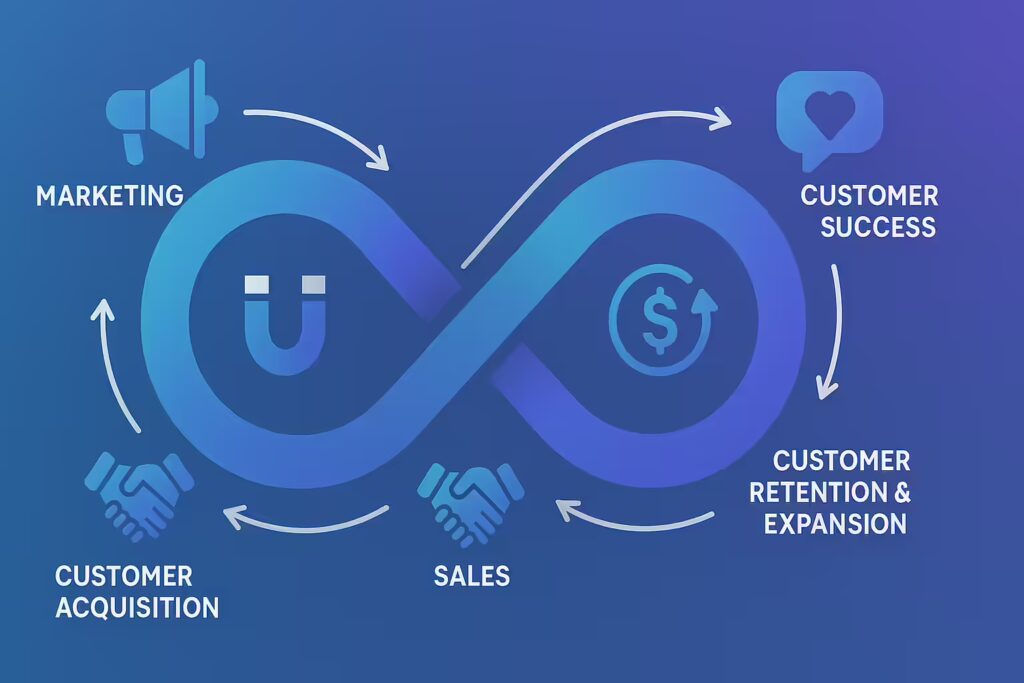
The L2R Scope: From First Touch to Lifetime Value
The most significant departure from the traditional model is the scope of L2R. It does not conclude when a payment is received. Instead, it deliberately extends the revenue lifecycle to encompass the entire post-sale relationship, recognizing that the initial transaction is just one milestone in a much longer journey. The L2R framework is composed of two interconnected components:
- Customer Acquisition: This includes all the activities traditionally associated with L2C, such as identifying market demand, generating and nurturing leads, and converting them into new customers.
- Customer Retention & Expansion: This is the critical extension. L2R explicitly incorporates the strategies and activities required to deliver ongoing value, ensuring retention and creating opportunities for successful cross-selling and upselling. A core tenet of L2R is the maximization of Customer Lifetime Value (CLV).
The L2R Philosophy: Aligning the Entire Go-to-Market Team
The foundational principle of the L2R framework is the dissolution of departmental silos. It mandates a strong, collaborative relationship between Marketing, Sales, and Customer Success, uniting them with a shared accountability for revenue outcomes. This represents a fundamental shift from being “company-process-centric” to “customer-journey-centric.” The L2C model is defined from the inside-out, structured around a company’s internal departments. The L2R model, in contrast, is designed from the outside-in, architected around the “buyer’s journey” and the “customer lifecycle.” The objective is to deliver tangible value at every stage to maximize the customer’s long-term success and, as a direct result, their lifetime revenue contribution.
The Core Distinction – Are You Chasing Cash or Building Revenue?
The confusion between Lead-to-Cash and Lead-to-Revenue often stems from a misunderstanding of their philosophical endpoints. The primary focus and ultimate measure of success for L2C is “cash”. Cash is a measure of liquidity—the immediate financial resources a company has on hand. The goal is to convert a sale into cash in the bank as quickly as possible.
In stark contrast, the true endpoint of the L2R framework is “revenue”—specifically, predictable, recurring, and expanding revenue. This is a measure of sustainable growth and overall enterprise value. A business that optimizes for “cash” is prioritizing short-term financial health. A business that optimizes for “revenue,” in the strategic sense of the L2R framework, is prioritizing long-term, scalable growth and the maximization of its valuation.
L2C vs. L2R at a Glance
| Feature | Lead-to-Cash (L2C) | Lead-to-Revenue (L2R) |
|---|---|---|
| Core Philosophy | Transactional & Operational: Focuses on executing a linear process efficiently. | Strategic & Relational: Focuses on managing a cyclical, ongoing customer relationship. |
| Scope | First Contact to Final Payment: Ends when the invoice is paid. | Entire Customer Lifecycle: Includes post-sale, retention, and expansion. |
| Primary Goal | Accelerate Cash Flow: Improve operational efficiency and reduce DSO. | Maximize Predictable Revenue: Increase Customer Lifetime Value (CLV) and Net Revenue Retention (NRR). |
| Key Departments | Often Siloed: Marketing, Sales, and Finance operate with distinct goals. | Aligned Go-to-Market: Marketing, Sales, and Customer Success share revenue goals. |
| View of Customer | A transaction to be processed and closed. | A relationship to be nurtured for long-term growth. |
| Endpoint | Cash in the Bank: A liquidity event. | Recognized & Recurring Revenue: A growth metric. |
| Technology Focus | Connecting disparate point solutions (CRM, ERP, Billing). | Unifying all GTM data and workflows on a single platform. |
A Tale of Two Scorecards – How KPIs Shape Your Revenue Strategy
The metrics a company prioritizes dictate its culture and strategic direction. The contrast between L2C and L2R is most evident in the Key Performance Indicators (KPIs) they champion.
The L2C Scorecard: Measuring Operational Health
An L2C-centric organization measures success through a lens of operational efficiency. Key metrics include:
- Days Sales Outstanding (DSO): Measures the average number of days it takes to collect payment.
- Time-to-Close / Sales Cycle Length: Tracks the average time to close a deal.
- Quote Accuracy & Quote-to-Order Conversion Rate: Evaluates the efficiency of the quoting process.
These metrics are important for financial stability but are fundamentally myopic. They measure the transaction, not the relationship, and offer zero insight into the health of the customer base or potential for future growth.
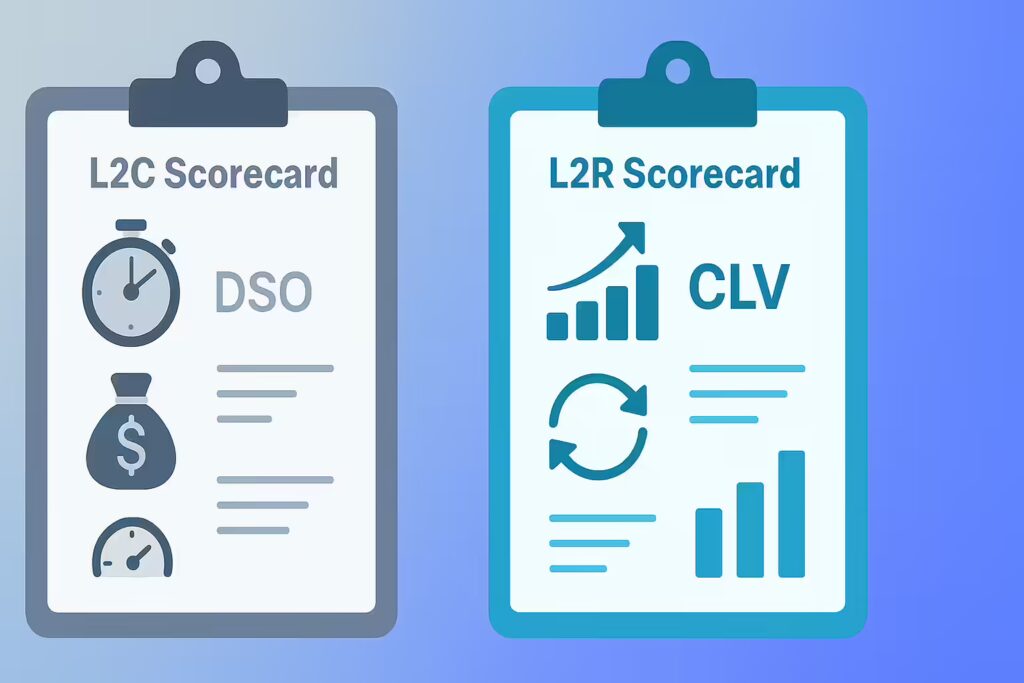
The L2R Scorecard: Measuring Strategic Growth
A modern, L2R-driven organization uses a scorecard that measures the health of the entire revenue engine. The most critical metrics include:
- Customer Lifetime Value (CLV): The total revenue a business can expect from a single customer over the entire partnership.
- Net Revenue Retention (NRR): Measures revenue from the existing customer base, factoring in expansion, contraction, and churn. An NRR over 100% is the gold standard for subscription businesses.
- Customer Acquisition Cost (CAC): The total cost to acquire a new customer, ideally analyzed in relation to CLV.
- Monthly Recurring Revenue (MRR) Growth: Demonstrates the predictable, compounding nature of the revenue stream.
An L2R scorecard centered on CLV and NRR cultivates a “land-and-expand” culture. It forces the entire go-to-market organization to align around a common purpose, from attracting the right-fit leads to ensuring customer success becomes a revenue driver.
Making the Leap: Technology and Transformation
Adopting an L2R philosophy is a strategic imperative, but it is practically impossible to execute using technology stacks built for a traditional L2C process. The core technological challenge is fragmentation. To make the leap, businesses must build a unified, customer-centric system.
The L2R Technology Ecosystem
At the heart of an effective L2R model lies a robust foundation of interconnected systems designed to provide end-to-end visibility and automation:
- Customer Relationship Management (CRM) Systems: The central nervous system for all customer data, providing a 360-degree view of every interaction.
- Marketing Automation Platforms (MAP): Crucial for nurturing leads with personalized, timely content based on their journey and engagement.
- Configure, Price, Quote (CPQ) Solutions: Vital for generating accurate and timely quotes in complex B2B environments, reducing errors and speeding up the sales cycle.
- Enterprise Resource Planning (ERP) and Billing Systems: Manage the financial aspects, from invoicing and payment collection to revenue recognition.
- Data Analytics and Business Intelligence (BI) Tools: Offer invaluable insights into customer behavior, campaign performance, and revenue trends to drive data-informed decisions.
- Artificial Intelligence (AI) and Machine Learning (ML): A game-changer for providing predictive analytics, identifying churn risks, and guiding sales execution.
Enter the Revenue Orchestration Platform (ROP): The Technological Linchpin
While each of these tools is powerful, the challenge lies in the data silos and disconnected processes that exist between them. The solution to this technological gap is the Revenue Orchestration Platform (ROP). An ROP acts as the “command center” for a company’s entire revenue operation, designed to unify teams, processes, and data onto a single, integrated platform. It is a unifying layer that sits on top of and integrates with existing systems like the CRM and ERP, transforming them from passive systems of record into an active, intelligent system of engagement for the entire go-to-market team.
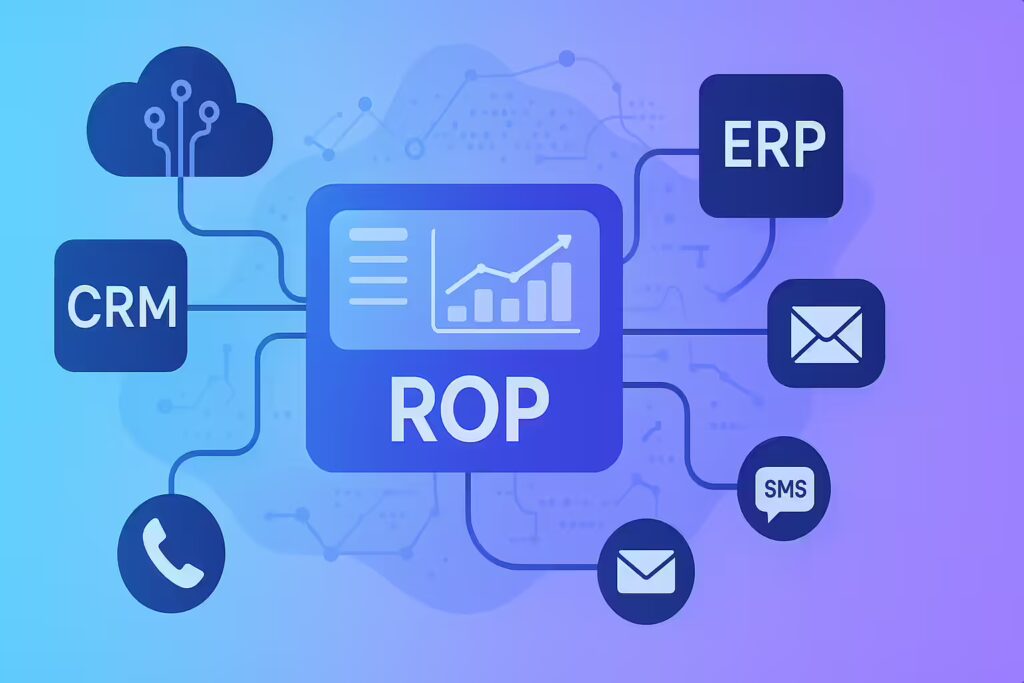
A Revenue Orchestration Platform like Kixie is designed to directly address the core challenges of fragmentation by:
- Unifying Data and Communication: It breaks down data silos by integrating all customer interactions—calls, emails, SMS—into a unified view within the CRM.
- Orchestrating Cross-Functional Workflows: It automates complex workflows across the customer journey, ensuring seamless handoffs between Sales, Customer Success, and Finance.
- Providing AI-Driven Insights: It leverages AI to analyze interaction data, surfacing predictive insights about deal health, customer sentiment, and churn risk.
- Ensuring a Cohesive Customer Experience: By unifying all touchpoints, it ensures every interaction is consistent, contextual, and personalized, building the trust that drives high CLV and NRR.
Implementing Your L2R Transformation: A Phased Approach
Adopting this L2R philosophy may seem daunting, but it can be achieved through a methodical, phased approach.
- Assess Your Current State and Define the Process: Begin by thoroughly documenting your existing processes. Interview marketing, sales, finance, and support teams to identify friction points and opportunities for improvement throughout the entire customer journey.
- Define Clear Goals and KPIs: Establish SMART (Specific, Measurable, Achievable, Relevant, Time-bound) revenue goals and define the L2R KPIs (CLV, NRR, CAC, etc.) you will use to measure progress and demonstrate ROI.
- Foster Strong Sales and Marketing Alignment: Break down departmental silos by creating shared goals, agreeing on a unified Ideal Customer Profile (ICP), and establishing clear lead qualification criteria and service-level agreements (SLAs).
- Standardize and Automate Workflows: Standardize procedures across departments to minimize inconsistencies. Prioritize automating repetitive tasks in lead nurturing, quoting, invoicing, and payment collection to enhance efficiency and reduce errors.
- Invest in Integrated Technology Solutions: Leverage the right technology stack (CRM, MAP, CPQ, etc.) and unify it with a Revenue Orchestration Platform to eliminate data silos and establish a single source of truth.
- Focus on Post-Sale Engagement and Continuous Optimization: Extend your focus beyond the initial sale to customer retention and expansion. Continuously monitor your KPIs, collect customer feedback, and conduct regular process audits to adapt and improve.
Stop Processing Transactions, Start Orchestrating Revenue
The distinction between Lead-to-Cash and Lead-to-Revenue is far more than a matter of semantics. L2C is an essential but insufficient operational process, designed for a transactional world that no longer exists for most B2B companies. L2R is the modern strategic framework required for sustainable growth in the subscription economy. Its focus on the entire, cyclical customer relationship aligns the whole organization around the metrics that truly matter: lifetime value, retention, and predictable, recurring revenue.
The future belongs to organizations that can master the entire revenue lifecycle, from the first marketing touchpoint to the tenth renewal and beyond. The question for revenue leaders is no longer if they should adopt a Lead-to-Revenue strategy, but how to execute it effectively. The L2R framework provides the map, but a Revenue Orchestration Platform is the engine.
Discover how Kixie can power your transition from chasing cash to building a predictable, scalable revenue machine.
Frequently Asked Questions
1. What is Lead-to-Cash (L2C)?
Lead-to-Cash (L2C) is an end-to-end business workflow that covers the journey from identifying a potential customer (lead) to collecting payment for a product or service. Its primary focus is on the efficient execution of the sales transaction, covering lead management, quoting, contracting, order fulfillment, invoicing, and payment collection.
2. What is Lead-to-Revenue (L2R)?
Lead-to-Revenue (L2R) is a broader, strategic engagement model that aligns marketing, sales, and customer success around the shared goal of maximizing predictable revenue. It extends beyond the initial transaction to focus on the entire customer lifecycle, including retention, expansion, and maximizing Customer Lifetime Value (CLV).
3. How do Lead-to-Cash and Lead-to-Revenue differ in scope and focus?
The key difference lies in their endpoint and philosophy. L2C is an operational process focused on transactional efficiency, ending when cash is collected. L2R is a strategic framework focused on relational growth, extending through the entire customer lifecycle to maximize long-term, recurring revenue. In short, L2C chases cash; L2R builds enterprise value.
4. What are the key benefits of optimizing both processes?
Optimizing both frameworks delivers comprehensive benefits:
- Increased Profitability: Faster conversions and a focus on customer lifetime value drive sustainable revenue growth.
- Enhanced Customer Loyalty: A seamless and consistent journey fosters satisfaction, leading to better retention and referrals.
- Improved Operational Efficiency: Automating workflows and integrating systems reduce manual errors, shorten sales cycles, and free up teams for strategic activities.
- Better Data-Driven Decisions: A unified view of customer data enables accurate forecasting and the ability to quickly identify and resolve bottlenecks.
5. What common elements do L2C and L2R share?
While their philosophies differ, both frameworks rely on a similar set of foundational activities. They both require effective lead generation and nurturing, a robust lead qualification process, sales process optimization, and the integration of core business systems like CRM and ERP to ensure smooth data flow.
6. Why is aligning sales and marketing so important for success?
Sales and marketing alignment is non-negotiable in either model. When both teams work from a shared understanding of the ideal customer, use the same data, and pursue common revenue goals, the entire process becomes more efficient. This collaboration ensures that marketing generates high-quality, sales-ready leads, which shortens sales cycles, increases conversion rates, and directly impacts the bottom line.
7. What technologies are commonly used to support these frameworks?
A modern revenue engine relies on an integrated technology stack:
- Customer Relationship Management (CRM): The core system of record for all customer data (e.g., Salesforce, HubSpot).
- Marketing Automation Platforms (MAP): For lead nurturing and campaign management (e.g., Marketo, Pardot).
- Configure, Price, Quote (CPQ) Software: To automate and streamline the creation of accurate sales quotes.
- Enterprise Resource Planning (ERP) Systems: For back-office functions like billing and financials (e.g., NetSuite, SAP).
- Revenue Orchestration Platforms (ROP): A unifying layer, like Kixie, that integrates these disparate tools, automates cross-functional workflows, and provides unified intelligence to power an L2R strategy.


